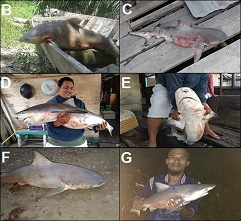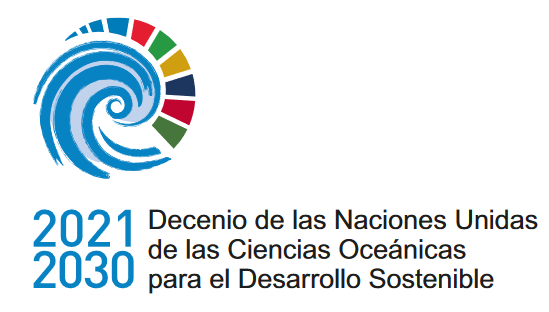Nuevos registros continentales del tiburón toro Carcharhinus leucas de Sumatra, Indonesia
DOI:
https://doi.org/10.47193/mafis.3532022010905Palabras clave:
Biogeografía, Carcharhinidae, elasmobranquios, agua dulce, conservación, área con datos escasosResumen
Se reportaron por primera vez seis nuevos registros del tiburón toro Carcharhinus leucas en cinco cuencas fluviales diferentes de Sumatra, Indonesia, como resultado de las capturas de pescadores artesanales y deportivos, incluidos registros de ríos del norte y oeste de Sumatra. Estos hallazgos resaltan la importancia de las cuencas de los ríos de Sumatra para la reproducción de esta especie amenazada en aguas de Indonesia. Los registros continentales de C. leucas en el Sudeste Asiático y, en particular, en Indonesia, son escasos pero importantes para la conservación de la naturaleza y la gestión pesquera sostenible en el futuro.
Descargas
Referencias
Boeseman M. 1964. Notes on the fishes of western New Guinea III. The freshwater shark of Jamoer Lake. Zool Meded. 40 (3): 9-22.
Compagno LJV. 1984. FAO species catalogue. Vol. 4. Sharks of the world: An annotated and illustrated catalogue of shark species known to date. Part 2. Carcharhiniformes. FAO Fish Synop. 125 (4): 251-655.
Ebert DA, Fowler SL, Compagno LJV. 2013. Sharks of the world: a fully illustrated guide. Plymouth, UK: Wild Nature Press. 528 p.
Ebert DA, Fowler SL, Dando M. 2021. Sharks of the world: a complete guide. Princeton, NJ: Princeton University Press. 624 p.
Garrick JAF. 1982. Sharks of the genus Carcharhinus. NOAA Tech Rep NMFS. 445: 1-194.
Gausmann P. 2021. Synopsis of global fresh and brackish water occurrences of the bull shark (Carcharhinus leucas Valenciennes 1839, Carcharhinidae), with comments on distribution and habitat use. Integr Syst: Stuttgart Contr Nat Hist. 4 (1): 55-213. DOI: https://doi.org/10.18476/2021.423083
Giareta EP, Prado AC, Leite RD, Padilha É, dos Santos IH, Wosiak CDCDL, Wosnick N. 2021. Fishermen’s participation in research and conservation of coastal elasmobranchs. Ocean Coast Manag. 199: 105421. DOI: https://doi.org/10.1016/j.ocecoaman.2020.10541
Grant MI, Kyne PM, Simpfendorfer CA, White WT, Chin A. 2019. Categorising use patterns of non-marine environments by elasmobranchs and a review of their extinction risk. Rev Fish Biol Fisheries. 29: 689-710. DOI: https://doi.org/10.1007/s11160-019-09576-w
Hasan V, Samitra D, Widodo MS, Gausmann P. 2021. A new inland record of the bull shark Carcharhinus leucas (Müller & Henle 1839) from Peninsular Malaysia. Sains Malays. 50 (10): 3153-3158. DOI: https://doi.org/10.17576/jsm-2021-5010-26
Heupel MR, Carlson JR, Simpfendorfer CA. 2007. Shark nursery areas: concepts, definition, characterization and assumptions. Mar Ecol Prog Ser. 337: 287-297. DOI: https://doi.org/10.3354/MEPS337287
Heupel MR, Simpfendorfer CA. 2011. Estuarine nursery areas provide a low-mortality environment for young bull sharks Carcharhinus leucas. Mar Ecol Prog Ser. 433: 237-244. DOI: https://doi.org/10.3354/MEPS09191
Iqbal M, Nurnawati E, Setiawan A, Dahlan Z, Yustian I. 2019. First photographic inland records of bull shark Carcharhinus leucas (Carcharhiniformes: Carcharhinidae) in Su-matran waters, Indonesia. Ecol Montenegrina. 22: 171-176. DOI: https://doi.org/10.37828/em.2019.22.14
Jaiteh VF, Hordyk AR, Braccini M, Warren C, Loneragan NR. 2017. Shark finning in eastern Indonesia: assessing the sustainability of a data-poor fishery. ICES J Mar Sci. 74 (1): 242-253. DOI: https://doi.org/10.1093/icesjms%2Ffsw170
Kottelat M. 2013. The fishes of the inland waters of Southeast Asia: a catalogue and core bibliography of the fishes known to occur in freshwaters, mangroves and estuaries. Raffles Bull Zool. 27: 1-663.
Last PR, Stevens JD. 2009. Sharks and rays of Autralia. 2nd ed. Collingwood: CSIRO Publishing Australia. 644 p.
Matich P, Heithaus MR. 2015. Individual variation in ontogenetic niche shifts in habitat use and movement patterns of a large estuarine predator (Carcharhinus leucas). Oecologia 178: 347-359. DOI: https://doi.org/10.1007/s00442015-3253-2
McCord ME, Lamberth SJ. 2009. Catching and tracking the world’s largest Zambezi (bull) shark Carcharhinus leucas in the Breede estuary, South Africa: the first 43 hours. Afr J Mar Sci. 31 (1): 107-111. DOI: https://doi.org/10.2989/AJMS.2009.31.1.11.782
Pillans RD, Fry GC, Steven ADL, Patterson T. 2020. Environmental influences on long-term movement patterns of a euryhaline elasmobranch (Carcharhinus leucas) within a subtropical estuary. Estuaries Coast. 43: 2152-2169. DOI: https://doi.org/10.1007/s12237-020-00755-8
Pillans RD, Good JP, Anderson WG, Hazon N, Franklin CE. 2005. Freshwater to seawater acclimation of juvenile bull sharks (Carcharhinus leucas): plasma osmolytes and Na+/K+‒ATPase activity in gill, rectal gland, kidney and intestine. J Comp Physiol. B 175: 37-44. DOI: https://doi.org/10.1007/s00360-004-0460-2
Pillans RD, Stevens JD, Kyne PM, Salini J. 2009. Observations on the distribution, biology, short-term movements and habitat requirements of river sharks Glyphis spp. in northern Australia. Endanger Species Res. 10: 321-332. DOI: https://doi.org/10.3354/ESR00206
Rigby CL, Espinoza M, Derrick D, Pacoureau N, Dicken M. 2021. Carcharhinus leucas. The IUCN Red List of Threatened Species 2021: e.T39372A2910670. DOI: https://doi.org/10.2305/IUCN.UK.2021-2.RLTS.T39372A2910670.en
Thorson TB. 1972. The status of the bull shark, Carcharhinus leucas, in the Amazon River. Copeia. 1972 (3): 601-605. DOI: https://doi.org/10.2307/1442947
Thorson TB. 1976. The status of the Lake Nicaragua shark: an updated appraisal. In: Thorson TB, editor. Investigations of the ichthyofauna of Nicaraguan lakes. Lincoln: University of Nebraska-Lincoln. p. 561-574. [accessed 2022 May 25]. https://digitalcommons.unl.edu/ichthynicar/41.
Wintner SP, Dudley SFJ, Kistnasamy, N, Everett, B. 2002. Age and growth estimates for the Zambezi shark, Carcharhinus leucas, from the east coast of South Africa. Mar Freshwater Res. 53 (2): 557-566. DOI: https://doi.org/10.1071/MF01062

Descargas
Publicado
Número
Sección
Licencia
Derechos de autor 2022 Peter Gausmann, Veryl Hasan

Esta obra está bajo una licencia internacional Creative Commons Atribución-NoComercial-CompartirIgual 4.0.
Los autores de los artículos publicados en Marine and Fishery Sciences conservan los derechos de autor de sus artículos, a excepción de las imágenes de terceros y otros materiales añadidos por Marine and Fishery Sciences, que están sujetos a los derechos de autor de sus respectivos propietarios. Por lo tanto, los autores son libres de difundir y volver a publicar sus artículos, sujeto a los requisitos de los propietarios de derechos de autor de terceros y sujeto a que la publicación original sea completamente citada. Los visitantes también pueden descargar y reenviar artículos sujetos a los requisitos de citas. La capacidad de copiar, descargar, reenviar o distribuir cualquier material siempre está sujeta a los avisos de derechos de autor que se muestran. Los avisos de copyright deben mostrarse de manera prominente y no pueden borrarse, eliminarse u ocultarse, total o parcialmente. El autoalmacenamiento en servidores y repositorios de preimpresión está permitido para todas las versiones.
Esta revista ofrece a los autores una política de acceso abierto. Los usuarios pueden leer, descargar, copiar, distribuir, imprimir, buscar o vincular los textos completos de los artículos, o usarlos para cualquier otro propósito legal dentro de la licencia Creative Commons 4.0 (BY-NC-SA), sin solicitar permiso previo del editor o del autor. Esto está de acuerdo con la definición BOAI de acceso abierto.
 https://orcid.org/0000-0003-3577-7349
https://orcid.org/0000-0003-3577-7349 https://orcid.org/0000-0001-5457-9335
https://orcid.org/0000-0001-5457-9335





















